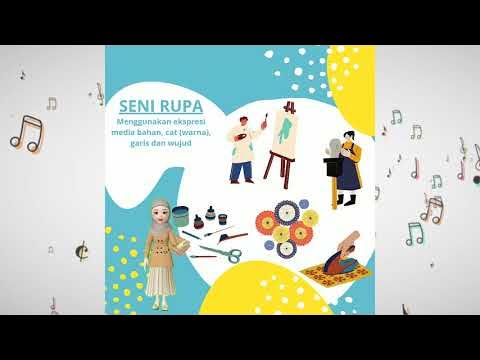metode penciptaan seni 01
Summary
TLDRThis transcript explores the concept of creativity in art, emphasizing its non-linear and unpredictable nature. It discusses how creativity arises from stepping outside of habitual patterns and embracing the unfamiliar. The speaker highlights the idea that true creativity challenges norms and opens up new possibilities, often starting with unconventional or seemingly strange ideas. The dialogue also contrasts rationality with creativity, suggesting that art, being non-rational, complements logic and enriches human understanding. Ultimately, creativity is portrayed as an exploratory process that evolves through experimentation and embracing uncertainty.
Takeaways
- 🎨 The method of art creation starts from small, unpublished works and is often taught academically, as shown in the course led by Professor Dr. Dwi Maryanto.
- 📖 Creativity, central to art, is about breaking away from the ordinary and exploring the unknown, not limited to predefined rules or norms.
- 🔍 Creativity is seen as neutral; it transcends art and applies to various fields. It involves stepping out of routines to discover new possibilities.
- 🌍 The process of creativity includes encountering unfamiliar things, which may be rejected or misunderstood because they challenge societal norms.
- 🤔 Creativity brings dualism (like right and wrong, black and white) into unity. It explores contradictions and merges them to create new understanding.
- 🌱 The act of creation is compared to discovering something new in a familiar space by paying attention to previously unnoticed details.
- ❓ True creativity isn't bound by rules or formulas. If it becomes structured, it loses its innovative essence and becomes narrow.
- 🌀 Creativity requires openness to the strange, unfamiliar, and possible without premature judgment or rejection.
- 🔨 The creative process involves both broad exploration (divergence) and focused refinement (convergence) to sharpen ideas and filter out distractions.
- 🔄 Originality in creativity is a synthesis of existing knowledge, experiences, and contradictions. Nothing is entirely new; it's about reinterpreting what already exists.
Q & A
What is the central theme of the video script?
-The central theme of the script is the method of art creation, focusing on creativity and how it breaks away from routine and norms to embrace new possibilities, strangeness, and unfamiliarity.
What is the significance of the 'jumping out-of-the-box' book mentioned in the script?
-The 'jumping out-of-the-box' book, though unpublished, serves as a key reference for understanding art creation methods taught by Professor Dr. Dwi Maryanto. It symbolizes the importance of stepping outside conventional boundaries to foster creativity.
How does the script define creativity in relation to art?
-Creativity is defined as stepping outside of everyday habits and exploring unknown possibilities. It involves creating something unfamiliar or strange, and while it may not be universally accepted, it challenges norms and expands artistic boundaries.
What is the connection between creativity and unfamiliarity as discussed in the script?
-The script emphasizes that creativity often manifests as unfamiliarity or strangeness. Creative works can seem foreign or odd because they deviate from established norms, and this unfamiliarity can lead to rejection before eventual acceptance.
How does the script approach the dualism of creativity in terms of 'yes' and 'no'?
-The script introduces the idea that creativity involves embracing both 'yes' and 'no' as part of a dialectic process. It suggests that creativity is about balancing opposites, such as acceptance and rejection, to explore new possibilities.
What is the relationship between art and rationality in the script?
-Art and rationality are depicted as opposing forces in a dualistic framework. Rationality relies on logic and structure, while art embraces the non-rational and emotional aspects of human experience. Both are necessary for a complete understanding of reality.
Why does the script emphasize 'not judging too quickly' in the creative process?
-The script advises against judging creative ideas too early because quick judgments can stifle the development of unconventional ideas. Creativity thrives on the exploration of unusual or unfamiliar concepts, which need time to mature before being evaluated.
What does the script suggest about originality in art creation?
-The script challenges the notion of complete originality, arguing that art creation builds on existing knowledge, theories, and past experiences. New creations are often syntheses or reconfigurations of what already exists.
How does the script describe the process of expanding and sharpening creative ideas?
-The creative process involves two phases: expansion and sharpening. Expansion is about exploring as many possibilities as possible without limiting the scope of ideas, while sharpening focuses on refining the most relevant aspects and discarding what doesn't fit the creative goal.
What role does 'possibility' play in the creative process according to the script?
-Possibility is central to creativity, as the script highlights the importance of remaining open to new, untested ideas. Creativity involves embracing uncertainty and the unknown, allowing for the emergence of novel and innovative concepts.
Outlines

このセクションは有料ユーザー限定です。 アクセスするには、アップグレードをお願いします。
今すぐアップグレードMindmap

このセクションは有料ユーザー限定です。 アクセスするには、アップグレードをお願いします。
今すぐアップグレードKeywords

このセクションは有料ユーザー限定です。 アクセスするには、アップグレードをお願いします。
今すぐアップグレードHighlights

このセクションは有料ユーザー限定です。 アクセスするには、アップグレードをお願いします。
今すぐアップグレードTranscripts

このセクションは有料ユーザー限定です。 アクセスするには、アップグレードをお願いします。
今すぐアップグレード5.0 / 5 (0 votes)






